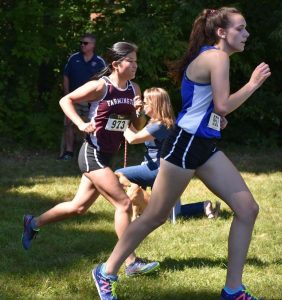
Oct 13, 2017 | Feature |
By Devin Lachapelle – Contributing Writer
As the fall semester nears its midpoint, student-athletes at UMF say that they’re able to balance demanding coursework with busy sports schedules thanks to hard work, effective time management and the help of friends and coaches.
Gwen Baker, a junior and member of the women’s cross country team, said that strong time management skills are extremely important for student-athletes given their often-crowded schedules.
“I like to joke that I don’t exist on Tuesdays; I’m busy from 5:30 a.m. to 7:00 p.m., with only a small break in the afternoon,” she said with a laugh. Baker then said, “It’s been a process to learn how to be organized as an athlete. I’ve been very organized because I’ve had to be.”
Michael Pingree, also a junior and a goalkeeper for the men’s soccer team, said that student-athletes often have to make difficult decisions in an effort to not get behind on schoolwork.
“You have to make tough choices and say no,” he said, “whether it be going out of town or going out one night, just because you have a game the next morning.”
Pingree stressed the importance of having a supportive group of friends to help stay motivated. “During the season, you have to have a friend group to keep everything balanced,” Pingree said. “You can really burn yourself out. To have a peer group that you can talk to about it or hang out with really helps.”
Junior and field hockey player Chelsea Ballard mentioned that her game schedule occasionally interferes with her classes. “Sometimes if I have a game on a Tuesday or Thursday night I’ll miss my Social Studies Methods class. We often leave early [for games], so I would miss my Public Writing class as well,” she said.
Ballard went on to describe the steps student-athletes have to take before any planned absences can take place. “Our coach has to sign off on a letter that tells the professor why we’re missing,” Ballard said. “Still, some professors don’t like it when we miss class.”
Ballard, like Baker, credits organization as the key to academic success for students with limited free time. “[Field hockey] takes away from my homework time,” she said. “Being both a student and an athlete, I have learned extremely good time management skills. I’m often going from one thing to another so I have to make sure I have everything organized and set up so I can make the smooth transition.”
Baker, whose athletic schedule also conflicts with her school schedule, stated that while her coaches try to maintain consistent practice times that work for most students, the coaches are flexible and do not penalize players when they do have to miss practice because of classes.

Gwen Baker (Left) competes against an opponent from Saint Josephs College (Right) during the UMF Invitational at Mt Blue High School in early September. (Photo Courtesy of C.J. Jenkins)
“Practice is at 3:45, which is usually a happy medium for everyone. I can’t run until after practice because I have Journalism then,” Baker said. “Coach knows I’ll still do the workout on my own.”
Moninda Marube, an assistant cross country coach at UMF since fall of 2016, agreed that coaches try to adapt to the needs of individual students.
“We work with their professors to ensure that classes do not fall on our training schedule or if they do, we always figure out how a student would best get their workout without missing a class.”
Marube emphasized that the key to academic and sports success was having players trust and support one another. “We have not had cases of students burning out yet,” he said. “We have caring team members who always seek to help each other to stand strong in their weak points.” Marube continued, “We have a great team chemistry and we address each member of our team at a personal level.”
Pingree and Baker both cited physical fatigue as a consistent challenge for student-athletes. Pingree said, “The biggest thing is how tired you are every day. You get home from practice, make dinner, shower, and by that time it’s already 7:00. The physical amount of preparation that goes into [sports] is the hardest thing for people to realize.” Baker said, “I’m usually exhausted coming home from weekend meets.”
Chris Strople, an Assistant Professor of Education at UMF, is the academic advisor to several varsity athletes. Professor Strople noted that student-athletes can be at risk of getting overwhelmed.
“Getting burned out by the high workload is certainly a concern,” he said. “I emphasize the importance of maintaining a balance . . . That balance is not universally achieved and so it often will be different depending on the person.”
Professor Strople, a former Division I water polo player at Loyola Marymount University, noted how important it is for student-athletes to have a support system in place. “I do have first-hand experience with the challenge of balancing the responsibilities of both athletics and academics . . . It’s not easy for anyone with the challenge of finding a balance between the two, so I would encourage them to communicate with their teammates, coaches, classmates, and professors for support when needed,” he said.
Baker, Pingree, Ballard, and Professor Strople all agreed that, despite the challenges faced by student-athletes, the connections made are well worth the effort.
“It’s not always about winning or losing,” said Professor Strople, “but often about the friendships built while working toward a collective goal.”
The women’s cross country team heads to Colby College for a meet on Friday, Oct. 6th at 4:00. A day later, the field hockey team will face off against New England College at 2:00 and the men’s soccer team will battle Green Mountain College at 3:30, both at home.
For more detailed information about the fall sports schedules, including schedules of sports not listed here, visit http://athletics.umf.maine.edu/landing/index.
Oct 13, 2017 | Feature |
By Samuel Carignan – Contributing Writer
UMF Career Services is organizing “Graduate School and Other Post-College Opportunities Month”, a month long event to help upperclassmen transition to post-graduation life. This October, students can visit several speakers whose talks will focus either on graduate school or employment opportunities.
The program is designed to help guide students towards a career path, whether that be graduate school, employment, or a service oriented program. UMF students will have the opportunity to speak with graduate school representatives from UMaine, Colby, Bates, Simmons and Husson. Employment and service opportunity presentations will be given about the Peace Corps, Fulbright and Teach In Alaska.
Cyndi McShane, who works in the Center for Student Development as a Career
Counselor and one of the key people involved in creating Graduate School Month, is hopeful that students will learn more about themselves and their next steps.
“The great thing about a liberal arts degree is that it prepares you for a variety of outcomes,” said McShane.
Ashley Hinkley, a UMF senior majoring in Elementary Education with a minor in Special Education, is one of hundreds of students who will need to be looking at what to do post-UMF. Her current goals are “[to find] a job teaching somewhere in the state of Maine, possibly getting my masters, and moving out of my mom’s house.”
Students have real concerns about what will happen after their undergrad journey at UMF. “The (education) field is so tight that it is going to be difficult, and I might get discouraged,” said Hinkley.
As an Education major, Hinkley wishes that the events could be more helpful for future educators. “They already provide job fairs and internship opportunities, so it would be nice for UMF to bring in teachers to come in and chat,” said Hinkley. “I would want to know what the first year of teaching is like, and the best ways I can go about getting a job.”
Career Services believes that the Graduate School and Other Post-College Opportunities Month will be helpful for many UMF students.
“It is [our] goal for students to leave our events with a desire to explore their options,” said McShane.
McShane also recommends setting up a one-on-one meeting with a career counselor to help with post-graduate plans.
“We want them to know they can be supported through this process,” says McShane.
For a full list of events, you can find posters and bulletin boards on campus, or contact a Career Services employee.
To reach out, or find out more information in general, visit their webpage at http://www2.umf.maine.edu/careers/.

Oct 13, 2017 | Feature |
By Gwen Baker – Contributing Writer
For many people at the Farmington Fair, the animals are an instant attraction. Fairgoers get to see a wide range of unique animals such as goats, cows and ducks.

Scout and Summit with their mother
(Scout: 8 years, top in purple and Summit: 7 years, bottom in green)
“What’s your name?”
“S-C-O-U-T,” replies Scout.
“And what’s your name sweetheart?”
“Summit.”
“How old are you two?”
“I’m eight,” says Scout
“Seven,” says Summit.
“Why are you drawn to the goats?”
“Cuz they’re cute and fluffy,” says Scout.
“And they’re lickable,” laughs Summit.
“Not likeable, but lickable?” asks their Mother.
“And they’re all different,” Scout adds.
“Do you guys go to the Farmington Fair every year?”
“We don’t come every year, as much as we can,” said their mother. “We live in Livermore.” The mother and the two girls moved down the enclosure to another group of goats.
“These guys like you better,” she said. The goats move towards the girls, sticking their heads through the wire. Both the girls kneel down and began patting the goats through the fence.
“Easy Summit they bite,” her mother advised.
“I know,” she replied.

Becca Beatty
(UMF student Becca Beatty poses with cow)
“Why do you like cows?”
“I first realized how awesome cows were on a family vacation to a farm in NH. I watched a baby cow get born and I also got to milk a cow. I asked my mom if we could get a cow and she said no! Every year during fair season, I try to convince her to let me buy a cow. If I were to buy a cow I would want it to be like a pet dog, it would live inside with me, but I don’t think I would fit inside my apartment. They’re like big dogs and I like dogs… and they lick my face.” She pointed to a baby cow. “I wouldn’t have space for a full grown cow, but possibly a baby. I could fit that size into my apartment. My mom however would not be impressed.” The cow started to lick her face. Laughing hysterically, she told it to stay still so it could pose for the camera. “It’s licking my face… It feels like a cat’s tongue only pricklier,” giggled Beatty.
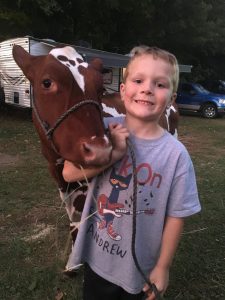
Andrew with Mother Lilly Bagley
(Andrew, age 8 years with Georgia)
“How long have you had the cows and what are their names and breed?”
“We’ve grown up with dairy cattle. It’s kinda our passion,” explained Lilly Bagley. “So we have three Milking Shorthorn and one Ayrshire. And we’ve had them for about two years now,” said Bagley. Pointing towards the fence where the four cows were, she began describing the cows.
“I have Rhonda to the left, and Georgia on the right of the pen. And then I have Gargamel, like from the Smurf Gargamel; she’s the brown one and Frozen, (far right) she’s considered a roan, the coloration of her is considered roan.”
4-H is a program that children from 5-18 can participate in and be involved in different projects, from agriculture to arts and crafts to robotics. Most clubs meet once a month and discuss business and come up with plans that members can do in their project.
“My oldest son [Jason] is able to be in 4-H now so he’s able to work with his own animals,” said Bagley. “My husband and I grew up with dairy cattle, went to college and kinda got out of it, then went back into it when the kids were old enough. He’s [Andrew] almost old enough.”
“To participate in 4h, they have to be nine. And then they do little classes for kids five to eight,” said Bagley.
“My favorite thing about raising dairy cattle is the bond that you form between each animal and that each heifer has its own personality.”
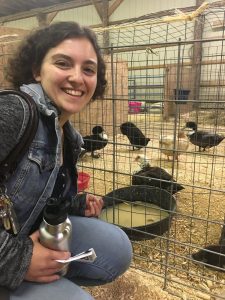
UMF student Elina Shapiro
(Elina Shapiro with Muscovy duck)
“Tell me a little bit about why you like birds?”
“I really have liked birds ever since I took Ornithology my freshman year in college. I took it actually in North Carolina, where I grew up, and ever since I took the class I fell in love with birds,” Shapiro reminisced.
“I’m an avid bird watcher and I love their diversity. I love seeing all the different kinds of birds while I’m out there and though I’d much prefer being out in the field and seeing birds, a lot of the birds that are in here, I have seen in the field.”
She pointed to the duck next to her. “One of which, one of the birds in here called the Muscovy duck was actually very prevalent right near my house and at the campus, I was at where I took Ornithology. It looks kind of funny, so every time I see it, it brings humor I guess you could say. It looks kinda like a combination of a chicken and turkey with warts. I mean it just looks very strange,” Shapiro laughed.
“I love bird watching. I also did a lot of bluebird research for two summers. So bluebirds are my favorite. I wouldn’t call that one my favorite [Muscovy duck], but it brings humor because it looks so funny,” said Shapiro.
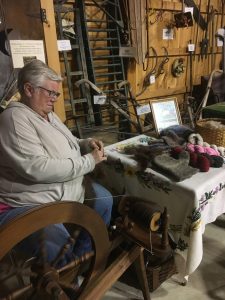
Diane Bolduc spins alpaca yarn on the machine.
“How long have you been spinning?”
“[I’ve been spinning for] twenty-seven years, I’ve been coming [to the Farmington Fair] for thirteen,” said Bolduc.
“What is the process of spinning, how does the machine work?”
“The process is shearing from a sheep or an alpaca, washing and carting it, combing it, then spinning it. I decide how thick or thin I want my yarn to be by thinning it out here. I pull it and thin it out and the spinning wheel twists it. All the spinning wheel does it twist it, and when I’m ready, I let it go. It runs through, it goes through the hole, comes out the others side and runs across these little hooks and winds up at the bobbin,” Bolduc replied, her hands swiftly gesticulating the movements as she demonstrates the process.
“And then when I’m all done I will apply it back on itself, which is twisting the two together, and it will be yarn ready to knit or crochet with,” said Bolduc.
“Does it take practice to get the handle of it?”
“Absolutely, it takes practice. When I first started, I was making rope. It was huge, it was thick, it was overspun. But it’s like anything, the more you do it, the better you get. The more practice. It’s a very touch feel, hands on type of activity. And once you learn how to do it, it’s like riding your bike; you have it forever.” She continued to spin, focusing on the process.
She later mentioned how children on class field trips call the sheep that are colored “Easter sheep.” as well as her amusement when men specifically ask her if they “really have sheep that color.”
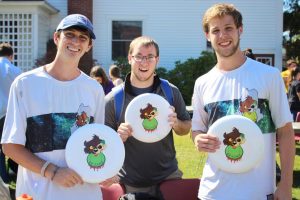
Sep 24, 2017 | Feature |
Emily Mokler – Contributing Writer
UMF’s Ultimate Disc Club focused on recruitment this Fall by showing off the fun and competitive sides of the game.
Tim Pacini, a UMF senior and co-President of the club, credits the increase in new members to playing on the Mantor Green.
“One of our biggest and best recruitment tools is simply tossing a disc on the green,” Pacini said. “People come and hang out, think it’s fun, come to a practice and they’re hooked.”
Justin Davis, a recent sophomore transfer, joined the club a few weeks ago. “When I first joined, I wanted to find something that would keep me active and moving,” Davis said. “I got into Ultimate because I saw people playing on the green, and they invited me to play with them.”
Davis was at the club fair on September 13th and “a lot of people were saying things like ‘I don’t know I’m not really that good.’ To them I usually say, neither am I,” he admitted. “We encourage anyone to join no matter the skill.”

Ultimate Disc Club Member’s at the Fall 2017 Club Fair from L to R : Cory McCullough, Justin Reid Davis and Tim Bullard. (Photo by Mitchell Walston)
Ultimate is like a combination of soccer’s running and football’s passing and field. Tim Bullard, a Senior Community Health major and captain of the team, said, “the running is physically demanding. In a tournament, playing up to ten games in two days is hard on your body.”
Bullard praised the new members of the club. “The freshmen this year are excited about playing,” he said. “They’re really enthusiastic about the game.”
Recent freshman recruit Sylvie Fenderson said, “I played ultimate in high school and knew I wanted to continue in college, whether with the team or just playing pickup.”
The team practices 5 days a week, but members don’t have to attend every practice. It’s a reflection of the flexibility the club has to offer. Bullard attends practice three times per week, and there are causal members who practice once per week. “It’s a much different atmosphere than varsity sports, which I’ve done in the past,” Bullard said. “It’s still competitive, but we have fun too.”
Exercise, competition and schedule flexibility are not the only contributing factors for player retainment. Bullard said, “Over the past four years, I’ve made friends through Ultimate, some are my best friends.”
Blair Bailey, a senior and the treasurer of the club, shared this sentiment. “The people who recruited me last year made it sound so fun so I thought I would give it a try,” Bailey said. “Those people have now become my current teammates, but even better they have become some of my closest friends.”
The Ultimate Disc Club has been a club sport at UMF since 1997. They fundraise by hosting tournaments at UMF, where Ultimate teams from other colleges register to play. The team went to Orono for their first tournament of the semester.
Pacini encourages interested students to “come on out to a practice and try it out. Look up the club’s Facebook page and join it to see practice times or if there’s a pick-up game going on.”
Their page can be found by searching Facebook for “UMF Ultimate Disc Club.”

Sep 23, 2017 | Feature |
Haiyu Zheng – Contributing Writer
UMF International students are doing a better job in adjusting to American campus life, despite various cultural differences for the first few weeks.

From L to R: Haiyu Zheng, Hui Shao, Clementine Leroy, Mana Abdi, Kasi Pratt, Cheyenne VanDooren, Pauline Barrier, Prescilia Ganache, and Elisa Ducept.
(Photo Courtesy of Cheyenne VanDooren)
The 14 international students/staff members initially had a hard time dealing with the differences in terms of the food, study, and lifestyle. In these 14, there are three language assistants, two staff members, seven exchange students and two J-1 students (International students study here for a degree).
These new members of the UMF community hail from various locations including France, Japan, China, Canada, Tanzania, and Argentina.
Chinese student Wenyi Lu became emotional after recalling an experience where she ran into financial issues.
“I almost wanted to cry when I found my bank account did not work here,” she said. “That was literally my hardest time since I came here.”
“There is a gap between my life in France and here,” said Prescilia Ganache, a French TA. “Everything is so different. The food, our thought patterns, even the way we dress,” she said. She recalled her initial shock when she found students wearing sandals and socks together. “In France, we always dress very formal,” Ganache said.
For some international students, the biggest adjustment has been the American food.
“They have more fat, sugar, and salt in food here compared to what I am used to,” said Clementine Leroy, another French TA. “Also, there are so many spices. I feel frustrated when I get something spicy by accident,” she said.
“I’m glad they try to make International foods that cater to us,” said Yuewei Zhang, a junior from China. “Even if they are fully Americanized.”
Academics were another concern for the International students. They found it hard to get involved in the class discussion. Clementine Gondo-Lescaillet, an International student from France, said that she was so stressed out about her marketing class.
“There were a lot of times when I came up with some ideas but it was too late to share due to my broken English,” she said.
Despite the difficulties, the International students have a positive mind towards the challenges and are trying to enjoy the life and find the beauty of this university.
“I appreciate the relationship between the students and professors,” said Asako Miyazaki, the Japanese instructor. She was surprised to find out the students are very casual in class.
“In Japan, students tend to be polite and always bow every time we see someone who’s older than us,” she said.
Kesuma Mkare, a freshman from Tanzania, said “American students do more sports than the students in my country. I like the idea that everyone wants to try something new.” Mkare was very happy to join the soccer team in UMF. “I got to meet a lot of people and made friends who care about me,” he said.
The International students also get sufficient support from UMF students and faculties.
Leroy was impressed by people’s hospitality. “The people all around the campus are always so friendly. If you have questions, you just go and ask them for help and you could always get more than what you expect,” she said.
The advisor of International Department Lynne Eustis put much effort in helping her students settle in during the orientation week.
“We prior to help them get ready for school life before other students arrive and get to know each other as a group so that they have an immediate network of support from friends, and also get some time to get familiar with the campus, the local downtown area,” Eustis said.
Stephen Riitano, a CA of Mallett Hall, also has a goal to help the International students adjust to the campus life more easily through some programs with them. “I am trying to be as open and inviting as possible,” said Riitano. “We like to invite the residents to come down and talk about some differences in the cuisine or anything interesting about their countries,” he said.
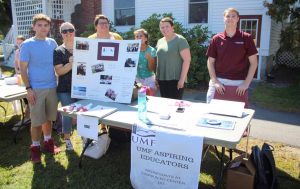
Sep 22, 2017 | Feature |
By Gavin Elliott – Contributing Write
After the recent name change approved by Student Senate, UMF Aspiring Educators, previously known as Student M.E.A. (Maine Education Association), seem to be growing in popularity.
Last year, the UMF Aspiring Educators were down to seven to ten members. The level of involvement was higher in the past, according to Beth Evans, a professor at UMF and faculty advisor for Aspiring Educators.
“When I first started teaching here at UMF around 20 years ago, just about every undergrad Ed Major was a member of at least one of the two education clubs,” Evans said.
This year at the first meeting, numbers had tripled when compared to the amount of members last year. This success is partially due to the club’s recent name change.

UMF Aspiring Educators of Maine at the Fall 2017 Club Fair
(Photo by Mitchell Agailb)
According to Stephen Riitano, the president of the Aspiring Educators, “the change was to align with the N.E.A. (National Education Association),” and to “let the students of UMF know that a membership to the student M.E.A. is not necessary, although UMF Aspiring Educators is still affiliated [with them].”
Aspiring Educators also held an Informational Meeting in the Ed Center along with Advocates for Disability Awareness Club (ADAC) and UMF Association for the Education of Young Children (AEYC). Through this meeting, the members of it are very much clubs hoped to inform new students, as well as current students, of what they each do.
Members of Aspiring Educators will often find themselves brainstorming and discussing upcoming events, fundraising, looking at poverty’s impacts on schools, connecting with other educators and learning skills they may not typically receive in their regular classrooms to aid in their professional development.
Professor Evans elaborated, “It is imperative to know what everyone else is doing in this profession. Early childhood to middle to special ed, etc. and this club does a great job of preparing ed students to do just this.”
Evans went on to say “The club is great because the movers and shakers of the professional life we call teaching.”
The treasurer of Aspiring Educators, Carson Hope, says, “The club is great because you get to network with other educators and clubs, and learn about the community part of teaching.” This networking can also impact more people by allowing them to pool their resources, said Evans.
According to Riitano, an example of the clubs pooling of their resources will be seen on September 26th when Kelly-Anne Rush, more commonly known as Crafty Teacher Lady, will be speaking at 5:30 pm in the Landing about how “teachers can be financially smart while providing meaningful and engaging lessons for their students.”
Later in October, they will be hosting Scare Fest, where “a panel of current teachers and administrators come to UMF and discuss the real side of teaching,” Riitano said.
For more information or any questions on the Aspiring Educators, like them on Facebook at “UMF Aspiring Educators of Maine,” or drop into any of their meetings on Wednesdays, room 106 of the Kalikow Education Center at 7:30 pm









